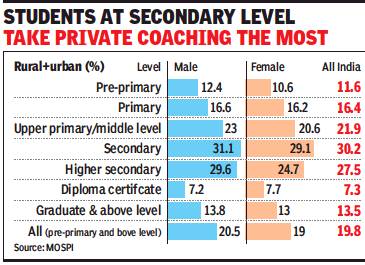Coaching classes/ centres: India
This is a collection of articles archived for the excellence of their content. |
Contents |
Coaching centres
As in 2019
May 27, 2019: The Times of India

From: May 27, 2019: The Times of India
The narrow winding stairs of a commercial building in Thane lead to a cramped basement where 70-odd students are scribbling something on their notebooks. A half-wall divides the space into two so that other classes can go on simultaneously. “There is no fire alarm or an extinguisher here. The rent is steep, so who will spend on these things?” a 17-year-old office boy, who has been working in the place for a year, quietly tells a TOI team. A few metres away, another coaching centre is operating on the terrace of a four-storey building. A tarpaulin sheet, which is highly inflammable, serves as a roof.
Firefighters douse a fire that broke out in a coaching centre in Surat killing 22 students
A blatant disregard of fire safety norms and blatant violation of building codes is what binds the 33,000-plus coaching centres that dot the lanes of Mumbai, Thane and Navi Mumbai. But it’s not just institutes in this metropolitan swathe that could be sitting ducks in case of a fire. There are Surat-like situations, where 20 young lives were lost in an inferno that engulfed a coaching school on Thursday, waiting to happen everywhere — Chennai, Ahmedabad, Kolkata, Hyderabad, Jaipur.
Lucknow could be worse. Some 2,000 coaching centres, whether they are in tony Hazratganj or crowded Aliganj, have not even bothered to get no objection certificates (NOCs) from the fire department. In fact, coaching centres operating from commercial buildings near railway stations, in dingy basements without windows and with single entry and exit points are quite the norm, with both parents and students taking their chances daily.
Away from Surat, in another part of Gujarat, at least two similar incidents were recorded in Ahmedabad this year. On March 8, a major fire broke out in a commercial complex housing several coaching centres on Anandnagar Road. Over 100 people had to be rescued. On January 30, another tragedy was averted when a group of 27 students were left trapped after a mattress shop located on the ground floor caught fire.
Months after the incidents, a visit to coaching centres in Ahmedabad shows it is business as usual. At Mangaltirth complex in Dharnidhar area, a narrow pathway is the only entry and exit point for about 10 coaching centres. Often fire safety is ignored by building owners to keep costs down.
In Mumbai, for instance, many coaching centres have cropped up near railway stations since students prefer them due to easy connectivity. “Rent is high so owners cut costs. Only a few get fire safety audits done on a regular basis,” says Sachin Karnavat, president of the Maharashtra Class Owners’ Association, adding that what works in their favour is that there is no law to specifically regulate coaching centres.
“The draft of the Maharashtra Private Coaching Classes Regulatory Bill, which is yet to be tabled, is silent on guidelines. It simply mentions that coaching classes need to comply with fire safety norms, with no specific details,” Karnavat adds.
In Jaipur, where roughly 50,000 students are enrolled in coaching centres, several institutes are not even registered. Many run from private bungalows and several have glass walls which make them even more susceptible in case of fire. Go down south, and the story is no different.
In Hyderabad, Ameerpet, the hub of private coaching centres, has hundreds of technical and skill development institutes operating in crammed spaces, with little regard for fire safety norms. Officials estimate that at least 80% of the buildings do not meet minimum requirements. “It’s the municipality’s responsibility to inspect them routinely and ensure there are proper escape routes, fire extinguishers, sprinklers and booster pumps,” says regional fire officer V Papaiah.
In several institutions in Chennai, classes are packed to double their capacity, but many parents are desperate to get their children admitted. A man who did not wish to be identified said, “I’m worried after what happened in Surat but what option do I have. I send my daughter to the institute nearest to my house.”
But in the wake of the Surat tragedy, authorities in several states are indeed mulling strict action. Notices are being issued to buildings flouting norms.
Coaching institutes in Kolkata have begun conducting fresh audits to ensure safety of students. They should. At a hospital eight years ago, more than 90 people were burnt to death. Many say they haven’t forgotten images of patients already weak with illness trying to ward off a threat beyond anybody’s control.
Risk Factors
Coaching class buildings are congested, have narrow exits, no refuge area
Classes run from basement of commercial buildings with no ventilation
Electricity wiring in older buildings not replaced
Fire audits not done regularly
Fire extinguishers, sprinklers not available in most cases
Shadow Education
One out of every four students takes private tuition in India
In some states, over 75% students opt for private tuition
20% Indians pursuing degree courses,13% pursuing postgraduate courses avail of private tuition
(Source: NSSO Survey)
Need for jobs fuels rush to coaching centres
In 2018, over half-a-million applications for 13,000 police vacancies in Rajasthan
65,000 low-grade railway job vacancies saw 19 million aspirants
1.66 million applications for 8,300 clerical jobs in State Bank of India
Judicial verdicts
Coaching centres must go from residential areas: SC
The Times of India, Mar 9, 2016
Dhananjay Mahapatra
The Supreme Court said coaching centres in residential areas were a nuisance to women and the elderly and must shift out to commercial premises or institutional areas. A bench of Chief Justice T S Thakur and Justice U U Lalit refused to give any relief to petitioner All Rajasthan Coaching Institutes Association, which had challenged the eviction order served on its members by Jaipur Development Authority, following a Rajasthan high court order banning functioning of tutorials illegally from residential colonies.
"Morning and evening, youngsters come with bikes. Many loiter around, harassing women and old people. Coaching centres must shift out to commercial premises or institutional areas. We will not permit them in residential areas," the bench said.
Appearing for the petitioner, senior advocate Kapil Sibal tried his best to get an interim stay on the eviction notice by arguing it was beyond the jurisdiction of the authority which had served the eviction notices on 118 coaching institutes operating from the Lal Kothi residential area in Jaipur. The bench was unimpressed and asked Sibal's client to respond to the eviction notice and move the court as and when the final order for vacating the premises in residential areas was passed by the authorities. The bench appeared firm against tutorials and coaching centres operating from residential areas.
"Why should these institutes be permitted to operate from residential areas and make lives of many miserable? These institutes create chaos in residential areas," it said. In the high court, petitioner Ghasiram had argued that these coaching centres illegally mushroomed in about 15 colonies in Lal Kothi in violation of norms which provide that no coaching centre can function in an area where the width of the road was less than 40 feet.
"Most of the coaching centres are functioning in violation of this rule. They have become a source of sound pollution and other civic problems," the petitioner had said in the high court. JDA had said, "Barring three-four coaching centres in Lal Kothi, almost every coaching centre violates government norms. There are norms such as 300 yard space for the centre, separate toilets for boys and girls, a 40-feet wide road opposite the centre etc. JDA will not take the responsibility for their relocation."
Super 30
The Times of India, Jun 13 2016 : The Times of India (Delhi)
Sheezan Nezami
Super 30 engineers another feat: 28 set for IIT
Kumar is one of 28 students of Bihar's famed Super 30 who have cracked this year's edition of the highly competitive test that decides admissions to the IITs. Their achievement caps yet another successful year for
What is Super 30?
Super 30 -a free coaching centre for underprivileged IIT aspirants -courts global renown for its high success rate year after year. The boarding institute coaches only 30 poor students every year, and in 2016 saw the entire batch clear JEE (Mains).
Super 30 was founded by Anand Kumar along with former Bihar director general of police Abhyanand in the first decade of the 21st century. Abhyanand later dissociated himself from the institute. Students seeking admission to Super 30 have to clear a competitive test and then commit themselves to a daily 16-hour study routine for a year. The success, Anand said, was the result of students' hard work and sincereity. his immediate focus every year was to free students of the feeling that they had not been to good schools.
2016
After an analysis of the marks scored by this year's batch, Anand said while the 28 students were surely headed for IITs, the remaining two would also get into good engineering colleges.
Basant Kumar, son of an illiterate marginal farmer in Bihar's Gaya, was elated when he saw his name in the list of candidates who had cracked the Joint Entrance Examination (Advanced) 2016. His father cannot tell IIT from ITI, but is happy that his son has succeeded in his pursuit.
Ajit Kumar, son of a vege table vendor and one of the successful aspirants, credited “Anand sir“ with changing his life: “He is a big inspiration for all of us. He motivated us.“ Pushkar Kumar, the son of a schoolteacher, added, “My father earns around Rs 8,000 a month, which goes into my mother's treatment.Once I get a job I will help my father financially .“
Another Super 30 success, Bipin Kumar, said he almost dropped out of school after Class X as his family could not afford his education. “IIT was just out of the question,“ he said. Other successful candidates include the sons of a daily-wager and a private security guard.
Stage at which students seek private tuition
As in 2017-18

From: Surojit Gupta, Secondary-level students take coaching most: Survey, July 21, 2020: The Times of India
Secondary level students topped the number of students taking private coaching with 31% males and 29% female students taking recourse to this method, a recent NSSO survey has shown.
The report also showed that nearly 20% students attending pre-primary and above level (21% of males and 19% of females) were taking private coaching.
According to the final report of the 75th round of the survey information was collected on whether a student was taking/had taken private coaching relating to the basic course. Private coaching might be taken by a student individually or in a group, at home or in any other place, by a single or more tutors.
Private coaching is a thriving business across the country and according to a 2016 NSSO report more than 7.1 crore students were taking private coaching or tuition classes in addition to their basic education.
At the pre-primary level 11.6% of students across the country were taking private coaching but this number rose gradually at the upper primary and middle level to 21.9% and rose to 30.2% at the secondary level. It then tapered to 27.5% at the higher secondary level.
Experts attributed the trend of a larger share of students at the secondary level taking recourse to private coaching to the entrance exams for professional courses such as engineering and medicines.
Anil Swarup, former secretary school education in the ministry of human resource development, explained the increase of students taking private coaching to the different competitive examinations and said this was a result of the dichotomy between learning and understanding.